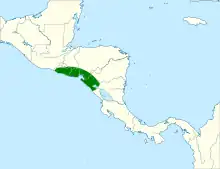Honduran fruit-eating bat
The Honduran fruit-eating bat (Artibeus inopinatus) is a species of bat in the family Phyllostomidae. It is found in El Salvador, Honduras, and Nicaragua.
| Honduran fruit-eating bat | |
|---|---|
| Scientific classification | |
| Domain: | Eukaryota |
| Kingdom: | Animalia |
| Phylum: | Chordata |
| Class: | Mammalia |
| Order: | Chiroptera |
| Family: | Phyllostomidae |
| Genus: | Artibeus |
| Species: | A. inopinatus |
| Binomial name | |
| Artibeus inopinatus Davis & Carter, 1964 | |
 | |
Description
Artibeus inopinatus is a fruit eating bat native to Central America, of the order Chiroptera, family Phyllostomidae.[2] Although the Honduran fruit-eating bat is considered data deficient by the IUCN,[1] accounts suggest that they display many of the characteristic features of the Neotropical fruit bats (Arbiteus), and are morphologically very similar to the close relative A. hirsutus.[2][3][4]
With an average weight of 36 g. the Honduran fruit eating bat is one of the smaller Neotropical bats, which typically range from 10-85 g.[2][6] It displays the characteristic lack of tail and narrow patagium seen in fruit bats, and also has a very densely furred uropatagium, which distinguishes A. hirsutus and A. inopinatus from many other species in the genus.[2] Like most bats, they are nocturnal, roosting during the day, and use echolocation for navigation at night.[6] The bats are in the family Phyllostomidae, also referred to as the New World leaf-nosed bats.[6] This group tends to have distinct pointed, or "leaf shaped" snouts which assist them in echolocation.[6]
Ecology
Distribution
The Honduran Fruit Eating bat has a relatively narrow range compared to other closely related species.[2] It is found along the pacific border of central America, from El Salvador to Nicaragua, and lives at much lower elevations than closely related bats in the genus, rarely exceeding 200 m above sea level.[2] The Honduran fruit-eating bat resides in thorn-scrub habitats, and have been captured in mist nets over streams and in banana groves. They are also known to use empty houses as day time roosts.[1][2]
Behavior
Honduran fruit-eating bats live in groups, with the females outnumbering the males significantly (there are accounts of 1 male living with 8 or more females).[1][2] The bats roost in protected shelters such as caves, or houses to shelter themselves from predators and weather. Their diet consists of fruit, insects, and some pollen.[6] The bats are also thought to undergo periods of dormancy similar to the closely related A. hirsutus.[2][6] Little is known about the lifestyle and mating habits and patterns of the Honduran fruit-eating bat.[2]
Physiology
The Honduran fruit-eating bats display poikilothermic characteristics, which is to say that their body temperature is able to rise and drop significantly.[2] When measured at different ambient temperatures, body temperatures as low as 29 °C and as high as 39.2 °C were recorded without the bat entering torpor.[2]
References
- Reid, F.; Medina, A. (2016). "Artibeus inopinatus". IUCN Red List of Threatened Species. 2016: e.T2132A21996586. doi:10.2305/IUCN.UK.2016-2.RLTS.T2132A21996586.en. Retrieved 15 November 2021.
- Webster, D & Knox, J. 1983. "Artibeus hirsutus and Artibeus inopinatus" Mammalian Species Account. The American Society of Mammalogists. Retrieved 6 November 2016.
- Redondo, R et al. (2008) "Molecular Systematics of the genus Artibeus" Molecular Phylogenetics and Evolution. Retrieved 6 November 2016.
- Larsen, P, Marchan-Revadeneira, M. and Baker, R. (2013) "Speciation Dynamics of the Fruit-Eating Bats (Genus Artibeus): With Evidence of Ecological Divergence in Central American Populations" Department of Biology, Duke university. Retrieved 6 November 2016.
- Marchan-Rivadeneira, M., et al. (2010) "Cranial differentiation of fruit-eating bats (genus Artibeus) based on size-standardized data" Acta Chiropterologica, 12(1); 143-154. Retrieved 6 November 2016.
- Simmons, N. (2005), "Chiroptera", in Wilson, Don E.; Reeder, DeeAnn M., Mammal Species of the World: A Taxonomic and Geographic Reference (3rd ed), Baltimore: Johns Hopkins University Press, pp. 312–529. Retrieved 6 November 2016.
